Fish Movements and Marine Protected Areas
Creating and Defining Marine Protected Areas
Most Marine Protected Areas (MPAs) in California are the result of the Marine Life Protection Act (MLPA) that was passed by the California State Legislature in 1999 and serve to protect the diversity and abundance of California's marine life, habitats, and ecosystems.
In California they can be classified into four different categories: State Marine Reserve (SMR), State Marine Conservation Area (SCMA), State Marine Park (SMP), or State Marine Recreational Management Areas (MMAs). While SMRs, like the Catalina Island Marine Science Center and Life Refuge, are no-take and no-use areas, SCMAs aim to conserve specific habitats and animal species, SMPs are limited take reserves, and MMAs limit the recreational use of an area.
Those who were responsible for the designation of MPAs included the California Department of Fish and Game (DFG), Blue Ribbon Task Force, Science Advisory Team, Regional stakeholder groups, and California citizens.
According to the State of California, a well-designed MPA should encompass both intertidal and offshore areas and span at least 3-6 miles offshore, although 6-12.5 miles is ideal. Habitat types should be replicated at least 3-5 times in each MPA and one MPA should be no more than 31-62 miles away from another. MPAs with these criteria may result in increases in population numbers and "spillover" events to non-protected areas. In addition, successful MPAs have higher abundances of harvested species than non-harvested species when compared to non-protected regions. Larger individuals of the harvested species should also be much more abundant in an effective MPA, and lead to a lower abundance of prey-sized species.
Many marine fish populations have shown signs of decline, due to anthropogenic influences such as overfishing and habitat loss. In order to develop ecologically resilient habitats, and please multiple demographics with different goals, MPA placement and design must be thoroughly thought-out and use the best available science for maximizing protection relative to management goals.
To learn more about MPAs in California, please visit the California Department of Fish and Wildlife.
Importance of Fish Movements and Habitat Use in Designing MPAs
Many marine animals move frequently on daily, monthly, or even yearly schedules, and the methods used to detect their fine-scale movements are time-consuming and expensive.
Fish movement studies are imperative to quantifying the success of currently designated MPAs and to designing future MPAs. Early knowledge of fish movements and dispersal came from fishery catch data and tag-recapture studies, which are often misused or misrepresented. More recent studies include remote sensing techniques such as acoustic and satellite telemetry have significantly improved our understanding of space and habitat use of tagged marine animals. For measuring movements of reef associated fishes, acoustic telemetry is most commonly used. Acoustic transmitters are used for both active, short-term, fine-scale movement tracking and passive, long-term, multi-individual monitoring; however, often at a much more coarse spatial scale.
Active tracking transmitters that have battery lives up to 61 days, where researchers will follow home ranging individuals for 24-hour increments over several months. Active tracking studies, which gather fine-scale spatial information can help to determine habitat uses, habitat preferences, and the sizes and locations of home ranges for various fish. Coded transmitters with battery lives up to several years are used for passive tracking and can be detected by underwater arrays of stationary omni-directional acoustic receivers (Fig. 1). These studies are useful for determining the site fidelity and seasonality of fish populations.
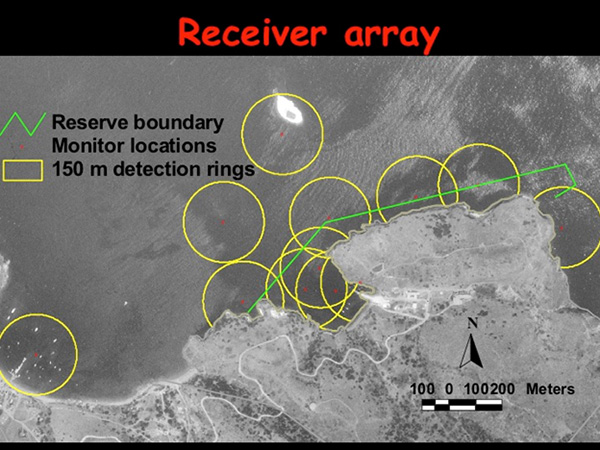
Since very little was known about the movements and habitat associations of California fishes, a habitat association model was developed to predict space use of nearshore fishes based on their affinity for complex substrata (e.g., rocky habitats). Species with lower affinities for complex substrata such as sand/mud are expected to require or use more space, and those that have no affinity for complex substrata were predicted to be nomadic (Fig. 2) (Lowe and Bray 2006).
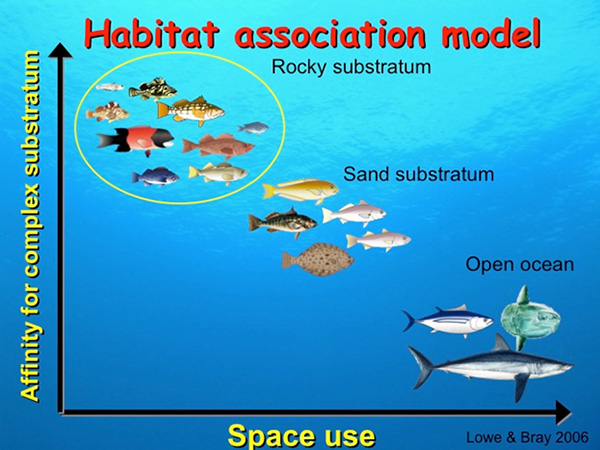
The Catalina Island Marine Science Center Marine Life Refuge
Several previous Shark Lab studies have used acoustic telemetry tracking to quantify movements and site fidelity of four important food and game fishes to an existing marine protected area in southern California. Ocean whitefish (Caulolatilus princeps), kelp bass (Paralabrax clathratus), barred sandbass (Paralabraz nebulifer), and California sheephead (Semicossyphus pulcher) were all tracked using both active and passive telemetry in Big Fisherman's Cove, which is part of the Catalina Island Marine Science Center Marine Life Refuge (CMLR) (Figs. 3, 4).
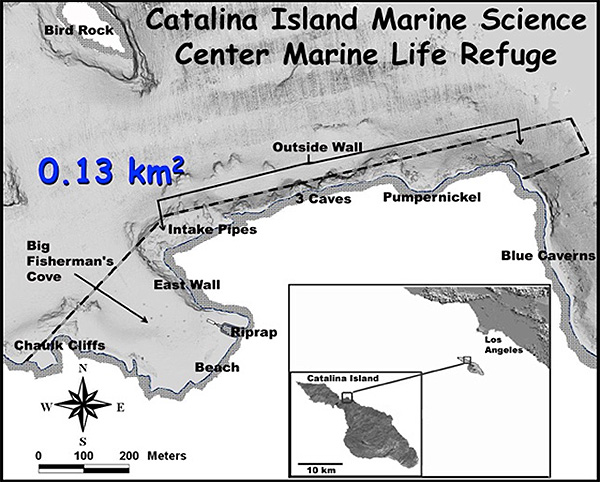
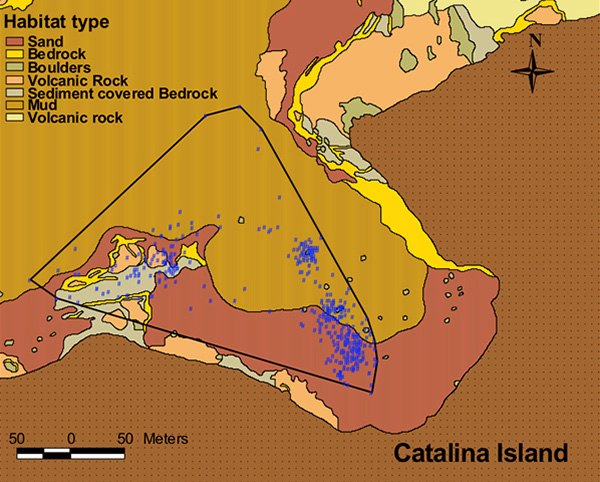
Some Study Results: An Overview
The benthic foraging species (e.g., ocean whitefish and California sheephead) in the refuge had larger home ranges and spent more time outside of the marine reserve than ambush predators (kelp bass and barred sand bass)(Figs. 5, 6). The ocean whitefish, California sheephead, and barred sandbass also showed diel (day-to-night) habitat shifts and some of the sheephead showed seasonal shifts in their home ranges. All species also showed a high degree of site fidelity, as they were still detected in the same home range area after one year (Fig. 7). In addition, all species apart from the kelp bass were highly associated with the soft-sediment and rocky ecotone (edge) habitat, which shows that the benthic composition of the MPA is important to the protection of these groups (Fig. 8). Based on these habitat use results managers can use this type of information to design tight or loose reserve boundaries that can either enhance protection or facilitate fisheries (Fig. 9).
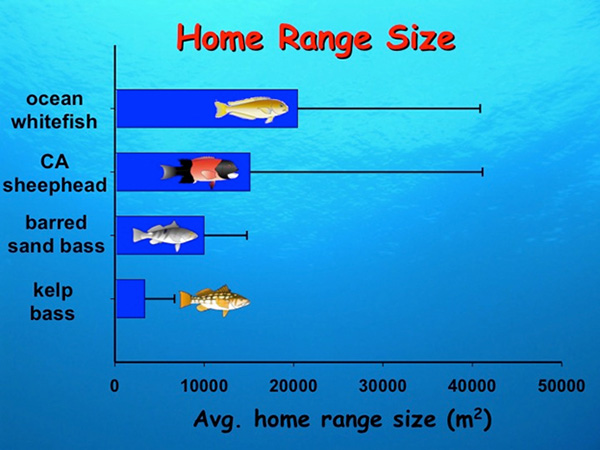
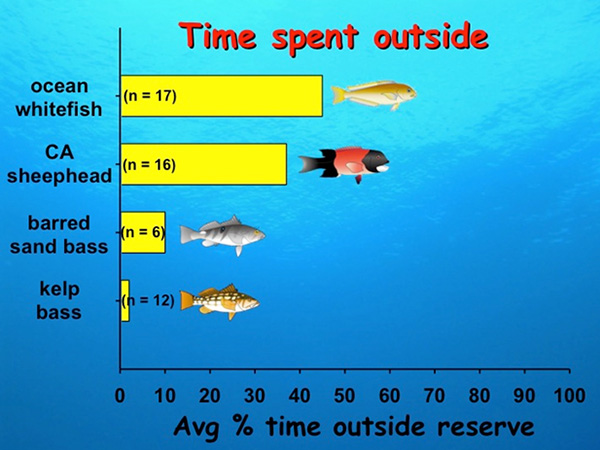
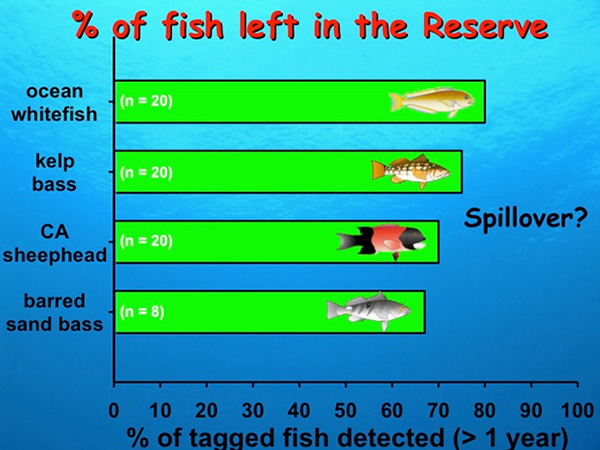
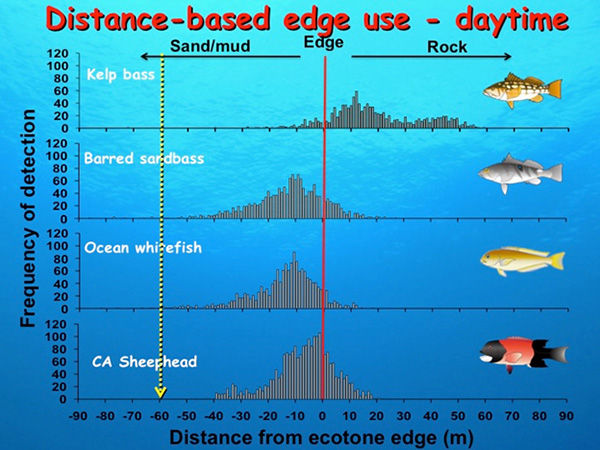
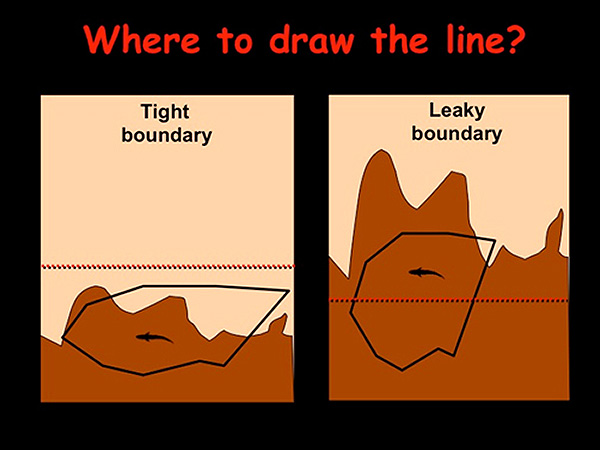
Kelp Bass
Kelp bass are generally found around nearshore, rocky reef habitats that extend from Baja, California to Monterey Bay. They are known to be diurnally active, with a high degree of site fidelity. Interestingly, previous studies suggest that juveniles move much more often than adults, and thus, have a lower degree of site fidelity until they reach maturity.
In this study, Dr. Lowe and his graduate students actively tracked kelp bass in the CLMR to characterize their movements and habitat use patterns (Lowe et al. 2003):
- Study duration: March 1999 – August 2001
- 12 adults actively tracked for 24-hour periods over 1 month
- 4 adults passively monitored for up to 4 months
While the home range of the tagged adult kelp bass varied among individuals, each remained within the confines of the MPA. The average home range size was 3,349 ± 2,238 m2, which only comprises 2.9 ± 3.0% of the total reserve area (Fig. 10). Because this small MPA has a diameter that is at least one order of magnitude larger than any one kelp bass' home range, it is likely effective for the protection of this population.
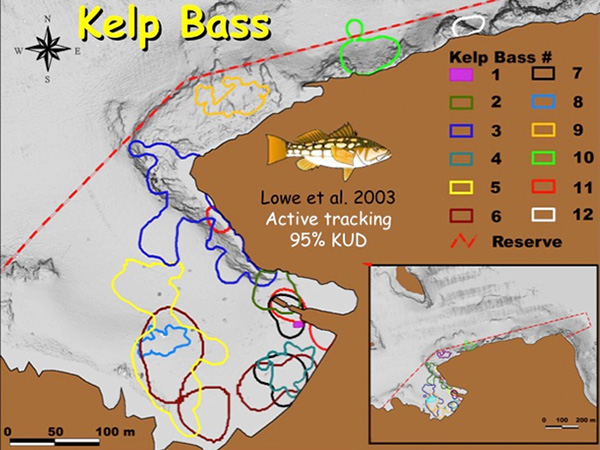
The largest of the tagged individuals showed diel movement patterns in which they opted for shaded areas during the day, and moved to cobble, rocky shores at night. The kelp bass were detected on either side of the ecotone, but showed no uniform association with the ecotone edge (Fig 11). Additionally, they used mud/sand geological habitats and kelp biotic habitats most of the time, but showed a preference for rock boulder substrata (Fig. 12). The mud/sand and kelp habitats probably provide more foraging and recruitment opportunities to the population.
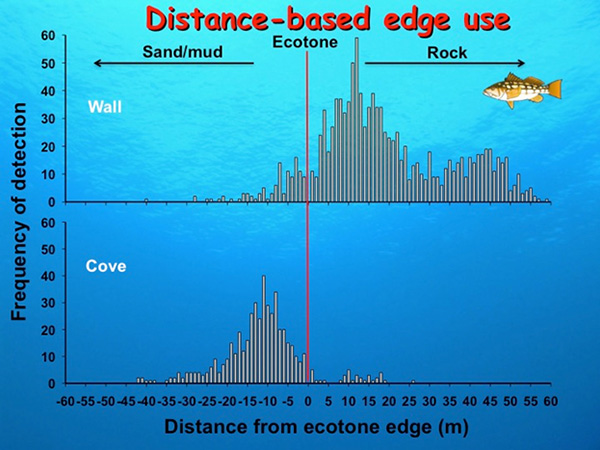
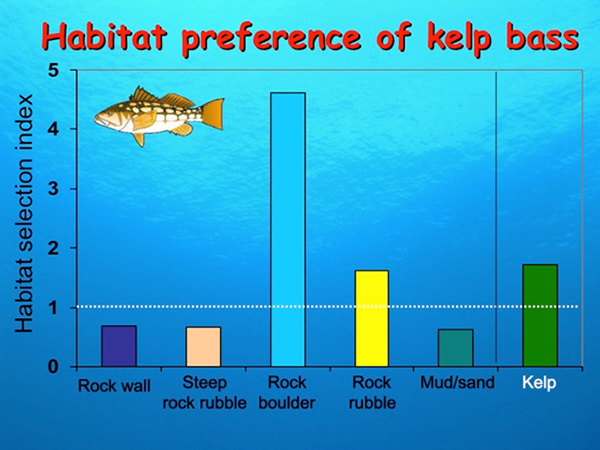
California Sheephead
California sheephead are carnivorous, temperate fish that tend to be associated with rocky-reefs and kelp beds. Sheephead are a protogynous hermaphrodites, and sex change is affect by social factors, which poses a particular problem for management efforts to size selection by fishers.
'This tracking study was part of Darin Topping's Master's thesis research and included both active and passive tracking of male and female CA sheephead in Big Fisherman's Cove (Topping et al. 2005, Topping et al. 2006).
Study duration:
- March 2001 – August 2002
- 16 adults actively tracked for 24-hour periods up to five months
- June 2000 – February 2002
- 16 adults passively monitored for one year
California sheephead home ranges varied with reef shape, but were an average of 15,134 ± 26,007 m2, which constitutes 11.16 ± 20% of the total reserve area (Fig. 13). Those tagged in the Cove had smaller, elliptical shaped home ranges, and those along the outside wall had larger, elongate shapes. Since individuals traveled beyond the confines of CMLR, we suggest that the population could be 100% protected if the refuge area extended at least 40 meters more offshore.
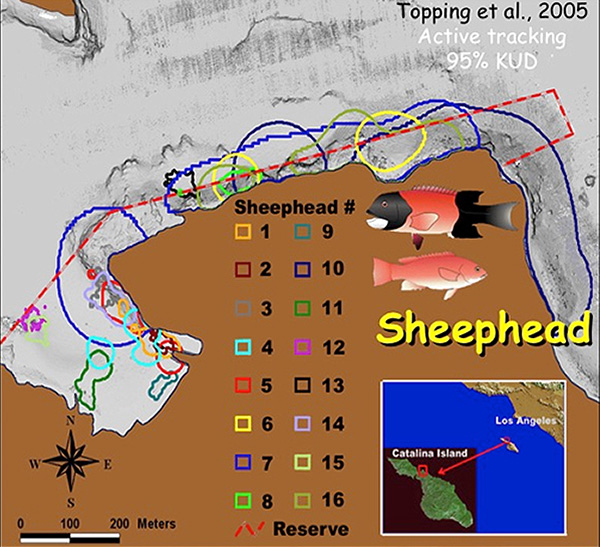
Similar to kelp bass, California sheephead are strictly diurnal and did not move more than one meter during the night. During the day, the sheephead used mud/sand and kelp habitats most often, but showed a preference for boulder habitats and a positive association with the sand-rock ecotone (Figs. 8, 14). Interestingly, the larger animals tracked within the Cove used mud/sand habitats more often, but larger individuals tracked along the outside wall used rocky reef areas more often.
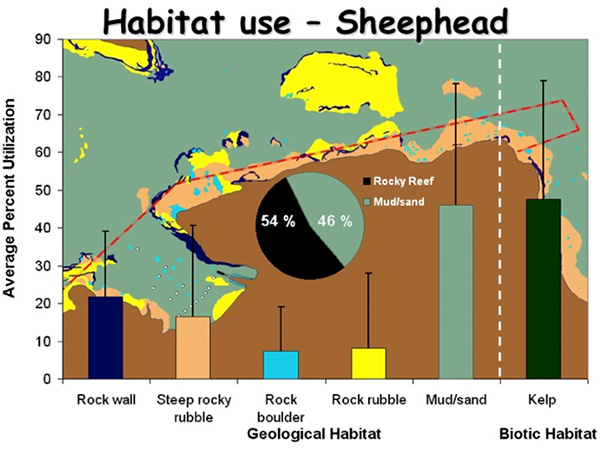
Most showed a high degree of site fidelity, but some (e.g. sheephead #6) showed site expansions in January 2002, and between December 2001 and March 2002 (Fig. 15). These seasonal home range shifts suggest that small reserves like the CLMR may be too small to effectively protect this population of sheephead.

Ocean Whitefish
Recreational anglers that target rockfish unintentionally catch ocean whitefish, which may have led to the declining population. Whitefish habitats span from British Columbia to Peru, and their primary food source is interstitial (sand-dwelling) invertebrates. Larval production is hypothesized to occur in the far south Mexican waters, and recruits peak between November and February in southern Californian waters at 15-60 meter depths.
Lyall Bellquist did this tracking study as part of his Master's thesis research (Bellquist et al. 2008).
- Study duration: November 2003 – June 2006
- 17 adults actively tracked for 24-hr periods over 1-2 months
- 17 adults passively monitored for one year
The ocean whitefish in this study were diurnally active, with individuals selecting deep, sand habitats during the day, but opted for shallow, bedrock slopes at night. The whitefish tracked exhibited an average home range of 20,439 ± 23,492 m2, but home range shapes were defined by the ecotone and surrounding benthic environment. Those near the outside wall had elliptical home ranges, while those near the cove had more circular shaped home ranges. Additionally, those that were tracked in areas with high-densities of other ocean whitefish had significantly larger home ranges (Fig. 16).
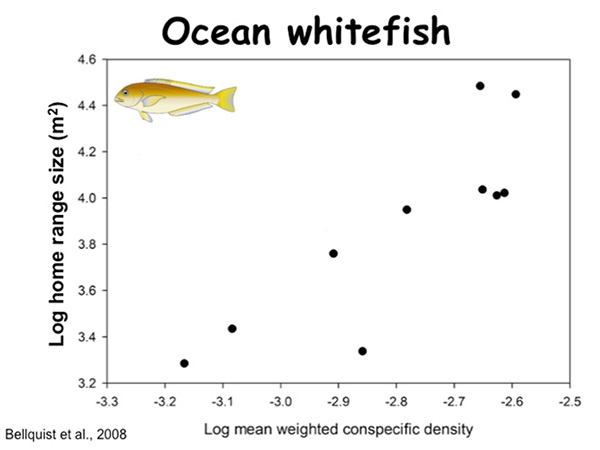
Ocean whitefish are a highly mobile species and traveled an average 3,781 ± 1,215 m/day. Acoustic monitoring also showed seasonality changes in home ranges, as whitefish were detected at much lower rates in June 2004 and November 2004. Due to the high mobility and seasonality of the species, the CMLR may be less effective for protecting individuals within this population.
Barred Sandbass
The barred sandbass is known to be an aggregate spawner and is among the top ten most recreationally caught species in Southern California. Members of this species tend to aggregate on the sandy sides of sand-reef ecosystems within three meters of the seafloor.
This study was part of Tom Mason's Master's thesis research. He actively and passively tracked barred sand bass in Big Fisherman's Cove at Catalina (Mason and Lowe, 2010).
- Study duration: Summers of 2005, 2006
- 6 adults actively tracked for 24-hour periods
- 8 adults passively monitored for one year
The average home range for the species was 10,003 ± 3,819 m2, most of which was composed of mud habitats (60 ± 15%). The sand bass that were tagged showed diel movement patterns in which they preferred soft-sediment habitats at night and nearby reef areas during the day. Like the ocean whitefish, the sand bass also exhibited a positive edge response between the rocky and soft-sediment ecotone (Fig. 17). MPAs that are located in areas with high edge density can therefore be very effective in protecting species with a positive edge response.
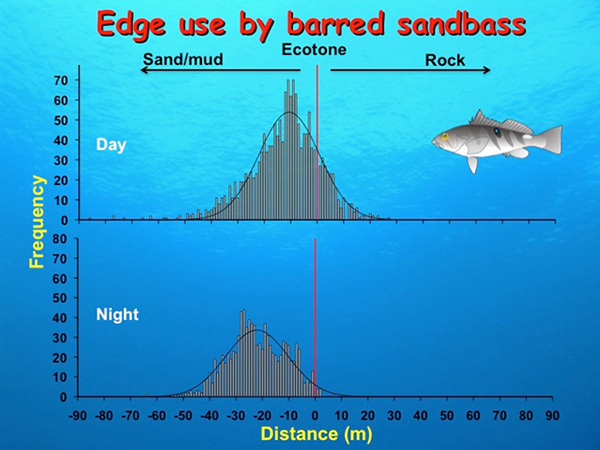
Only half of those tagged showed year-round site fidelity, which could correspond to instances of both resident and transient spawners in the population. Therefore, the current refuge area may be effective for the year-round protection of some individuals (resident spawners) and the seasonal protection of others (transient spawners).





